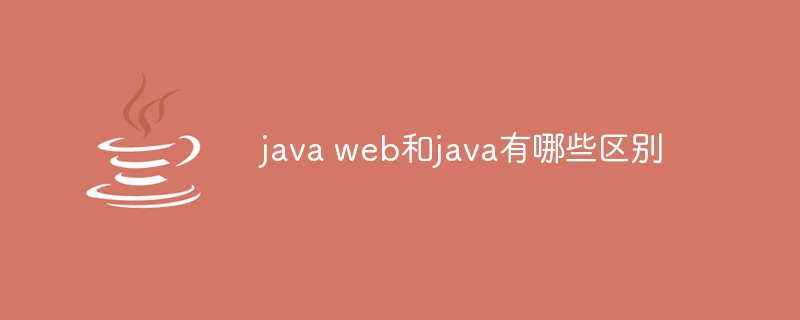
The difference between web and java lies in definition and purpose, architecture and components, development process, application scenarios, technology stack and framework, etc. Detailed introduction: 1. Definition and purpose. Java is an object-oriented programming language that is platform-independent and can run on different operating systems. It is widely used in various fields, including desktop applications, mobile applications, and embedded applications. Java Web is a set of technologies developed based on the Java technology stack for building Web applications, including Java Servlet and so on.

The operating system for this tutorial: Windows 10 system, DELL G3 computer.
Java is a general programming language, and Java Web is a technology stack developed based on Java for building Web applications. The differences between Java and Java Web will be explained in detail below.
1. Definition and usage:
- Java: Java is an object-oriented programming language launched in 1995 by Sun Microsystems (now Oracle). Java is platform independent and can run on different operating systems. Java is widely used in various fields, including desktop applications, mobile applications, embedded systems, etc.
- Java Web: Java Web is a set of technologies developed based on the Java technology stack for building Web applications. It includes technologies and frameworks such as Java Servlet, JavaServer Pages (JSP), JavaServer Faces (JSF), and JavaServer Pages Standard Tag Library (JSTL). Java Web is used to develop server-side Web applications, which can handle HTTP requests, generate dynamic content, interact with databases, etc.
2. Architecture and components:
- Java: Java’s architecture is based on the Java Virtual Machine (JVM). Java applications usually contain components such as classes, interfaces, packages, etc., and can use Java standard libraries and third-party libraries to implement various functions.
- Java Web: The architecture of Java Web is based on the client-server model. It uses Java Servlet as the server-side component responsible for handling HTTP requests and generating dynamic content. JavaServer Pages (JSP) allow developers to mix HTML and Java code to generate dynamic web pages. Java Web can also use JavaBean, JSTL and other components to handle business logic and data display.
3. Development process:
- Java: The development of Java applications usually includes writing source code, compiling to bytecode and running. Java developers use the compiler and runtime environment in the Java Development Kit (JDK) to develop and run Java applications.
- Java Web: The development of Java Web applications typically includes writing code for Servlets, JSPs, and other components, as well as configuring the Web server. Java web developers use the Java Development Kit (JDK) and Java web containers such as Apache Tomcat to develop and run Java web applications.
4. Application scenarios:
- Java: Java is widely used in various application development, including desktop applications, mobile applications, embedded systems, etc. It is a general-purpose programming language that can be used to develop various types of applications.
- Java Web: Java Web is mainly used to develop server-side Web applications. It can handle HTTP requests, generate dynamic content, interact with databases, and more. Java Web applications can be used to develop various web applications, such as e-commerce websites, social media platforms, enterprise applications, etc.
5. Technology stack and framework:
- Java: Java has many technology stacks and frameworks to choose from, such as Java standard library, Spring framework, Hibernate framework, etc. . These technology stacks and frameworks provide rich features and tools to help developers develop Java applications more efficiently.
- Java Web: Java Web also has many technologies and frameworks to choose from, such as Java Servlet, JSP, JSF, Spring MVC, etc. These technologies and frameworks provide functions such as processing Web requests, generating dynamic content, and managing sessions, helping developers develop Java Web applications more conveniently.
In summary, Java is a general programming language that is widely used in various fields. Java Web is a technology developed based on the Java technology stack for building web applications. Java Web uses Java Servlet, JSP, JSF and other components and frameworks to process web requests, generate dynamic content, interact with databases, etc. Java and Java Web have differences in definition, architecture, development process, application scenarios, and technology stacks, but they can complement each other and enable developers to develop powerful applications.
The above is the detailed content of What are the differences between java web and java. For more information, please follow other related articles on the PHP Chinese website!
